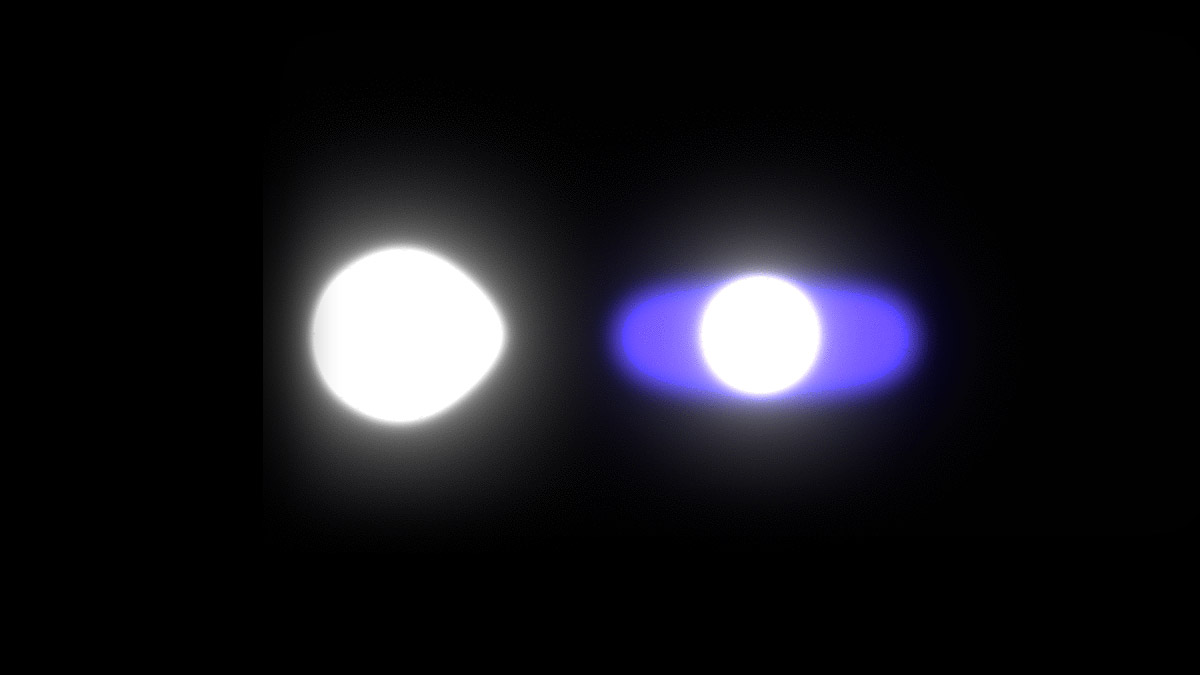If you look at any top list of astronomical targets in the constellation Lyra, you’ll most likely see Beta Lyrae, also known as Sheliak or Tsan Tae to the ancient Chinese. At magnitude +3.45, Beta Lyrae is bright enough to see with the naked eye in the constellation Lyra. This interesting binary joins a great group of objects in the area, including the famous “Double-Double” of Epsilon Lryae, the awesome Ring Nebula, and the quaint Eta Lyrae (Aladfar). There’s a whole star party happening up there!
A Fast Star Dance
As we learn more about Beta Lyrae, this binary becomes quite intriguing! At the center of attention lies the two stars named Beta Lyrae A and Beta Lyrae B. These two orbit each other every 12.9 days! We cannot separate the two visually in a telescope due to how close they are, but we witness regular and dramatic changes in their apparent brightness as they eclipse each other during their orbit. This phenomenon is known as an eclipsing binary, making Beta Lyrae one of the brightest and best-studied examples of this type of binary system.1
But there’s more. The close proximity of these two stars leads to a fascinating phenomenon called mass transfer. As the stars orbit each other, their gravitational forces distort their shapes, leading to the transfer of matter from the larger star (Beta Lyrae A) to the less massive one (Beta Lyrae B). This process fuels the accretion of material onto Beta Lyrae B, causing it to heat up and emit intense radiation. It’s this mass transfer and accretion that are responsible for the observed changes in brightness during the eclipses, ranging roughly from magnitude +3.2 to +4.3.
Shining Hot, Bright, and Blue
Beta Lyrae A is a hot, blue-white, and extremely luminous star. It belongs to the class of stars known as B-type stars and is significantly larger than our Sun, with a radius several times greater. The secondary star, Beta Lyrae B, is slightly cooler and less massive than its companion, yet it is still a powerful star in its own right. It should also be noted that several other visual companions surround Beta Lyrae A, including a magnitude +7.1 star lying 45 arcseconds away that has a spectral classification of B7.2
Discovery of Beta Lyrae’s Variable Character
Ancient astronomers have looked upon Beta Lyrae for thousands of years, and then in 1784, the English amateur astronomer John Goodricke discovered the variable characteristics of these dancing stars.
To understand more about this variable, I suggest visiting the AAVSO site.
My Observations
| Date | July 1, 2023 |
| Time | 11:41 p.m. |
| Location | Seattle, WA |
| Magnification | 169x |
| Scope | Meade 8″ SCT |
| Eyepiece | 12mm |
| Seeing | Above Average |
| Transparency | Above Average |

The Night Begins with Titanic’s Stars
As July begins with midnight near, I’m standing under a clear firmament. If only I could scare the rising full moon back to the east because the stars are dissolving into her rising light.
Earlier today, as I was mapping out my route through Lyra, I listened to the news about the tragic incident involving a submersible called Titan that imploded while en route to view the Titanic. All five passengers on board died. As I listened to the somber report, I thought again of the clear, moonless night when the Titanic sank more than 100 years ago. I viewed the star charts for 2 a.m. on April 15, 1912, and noticed how my 11 p.m. sky looked about the same. With the telescope set, I stepped back to view Vega, then my eyes moved to Ursa Major, then back to Polaris. I wondered how many of the survivors, if any, found solace in the stars to fight off the cold and violence of the night.
Beta Lyrae: A Short Hop from Zeta Lyrae Tonight
I arrive at Beta Lyrae after a short jump from Zeta Lyrae. The primary star shines brilliantly with a bluish-white hue. The surrounding dimmer stars (which I believe are related companions) are perhaps a touch warmer nearing bright white. My first thought is this grouping of stars looks like a miniature version of the constellation Scorpio.
Key Stats
| Constellation | Lyra |
| Best Viewing | Summer/Autumn |
| Visual Magnitude | +3.51 |
| Absolute Visual Magnitude | +3.2 to +4.3 |
| Distance from Earth | 960 ly |
| Position Angle | 150° |
| Milky Way Location | Orion Spur |
| My Viewing Grade | A- |
| Designations | β Lyrae, 10 Lyrae, AAVSO 1846+33, HD 174638, SAO 67451 |
Sources and Notes
Banner photo of Beta Lyrae adapter from visual animation created by Merikanto. The illustration is licensed under the Creative Commons Attribution-Share Alike 4.0 International license. Full details here.
1Encyclopædia Britannica, inc. (n.d.-a). Beta lyrae. Encyclopædia Britannica. https://www.britannica.com/place/Beta-Lyrae
2Beta lyrae. aavso. (n.d.). https://www.aavso.org/vsots_betalyr
Sketch by Wayne McGraw
